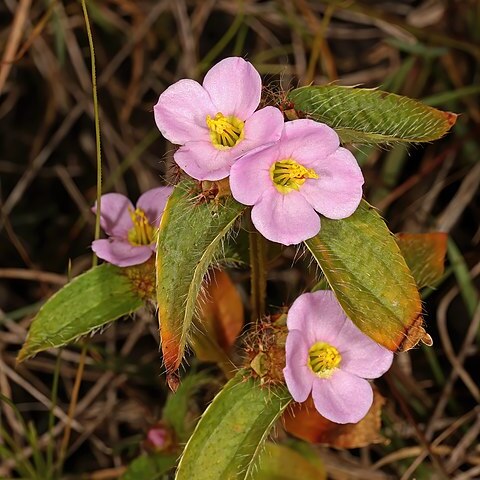Erect annual, rarely behaving as a biennial, (2.5–)4–35 cm. high; stem simple or branched, 4–angled, with appressed hairs on the angles, hairs somewhat spreading at the nodes.. Leaves decussate, progressively larger towards the inflorescence, often widely spaced (internodes up to 22 cm.); lamina narrowly ovate to oblong-ovate, up to 3.8 cm. long and 1.4 cm. wide, apex obtuse, base cuneate to subtruncate, sparsely strigose above and on the nerves beneath; venation impressed above, prominent beneath, with 3 or 5 ascending nerves; petiole 1–5 mm. long, pilose.. Inflorescence terminal or axillary, subtended by 1–2 pairs of leaves, capitate, up to ± 12-flowered; pedicels up to 3 mm. long.. Calyx 2.5 mm. long, 2 mm. in diameter, sparsely hairy; lobes narrowly triangular, persistent, 1 mm. long, with reddish stellately arranged bristles at the apex; intersepalar appendages ligulate, with reddish stellately arranged bristles at the apex.. Petals 4 mm. long, 3.5 mm. wide, pale mauve, with a tuft of hairs at the apex.. Stamens 3.5 mm. long; anthers 0.7 mm. long; free part of connective ± 0.5 mm. long, arched, 2-tubercled at the base.. Capsule rounded, 2.5–3 mm. long.. Seeds 0.4–0.5 mm. long, very finely papillose.. Fig. 3.
Annual herb, 0.06-0.38 m high; usually unbranched. Leaves increasing in size upwards, ovate to oblong, longitudinally 3-5-nerved, subappressed-pilose on both surfaces, more dense on nerves below. Flowers in terminal, capitate cymes, surrounded at base by 2-4(5) leaves. Receptacle broadly campanulate, appendages at summit with bristles inserted at apices. Sepals triangular-subulate, stellate-setose at apices. Petals pale mauve to pink. Stamens with anthers oblong, up to 2 mm long, obliquely truncate at apex; diam. of pore as wide as that of anther. Flowering time summer. Fructiferous receptacle roundish at base, somewhat contracted above capsule. Capsule slightly shorter than receptacle, with a ring of bristles around insertion of style.
Leaf-lamina 0·5–4·5(5–7) x 0·1–1·8(2) cm., increasing in size upwards, ovate to oblong, acute at the apex, contracted or acute at the base, entire or crenulate, the teeth ending in a bristle, membranous, concolorous, yellowish-green or pale green and sparsely subappressed-pilose on both faces, more densely so on the nerves beneath, 3–5-nerved; petiole 3–6(8) mm. long, setose.
Delicate annual herb, up to 380 mm tall. Leaves opposite, sparsely appressed-setulose. Flowers 4-merous, in terminal capitate cymes, surrounded at base by 2-4(5) leaves; pale mauve to pink.
Flowers in terminal capitate cymes, surrounded at the base by 2·4(5) leaves; pedicels c. 2·5 mm. long, setulose; bracts subequalling the pedicels, setulose.
Receptacle c. 2 mm. high, pale green, with sparse, brownish red or purplish bristles inserted towards the summit at the apex of little appendages.
Very similar to Osbeckia decandra (Sm.) DC. but distinguished by the 4-merous flowers and connectives with well-developed appendages.
Stem up to 38 cm. high (usually less), unbranched or with long ascending branches, laxly leafy, sparsely appressed-setulose.
Anthers (0·5)0·75–1·75 mm. long, with non-undulate cells; pedoconnective 0·5–2 mm. long; filaments c. 2 mm. long.
Sepals c. 1·5 mm. long, triangular-subulate, stellate-setose at the apex like the intersepalar segments.
Fructiferous receptacle c. 3 x 2·75 mm., roundish at the base, a little contracted above the capsule.
Ovary with a ring of bristles surrounding the base of the style.
Petals 5 x 3·5 mm., obovate, pale mauve to pink.
Seeds very minutely tuberculate.
Petals 4, pink or mauve.
Annual, to 1 ft. high

